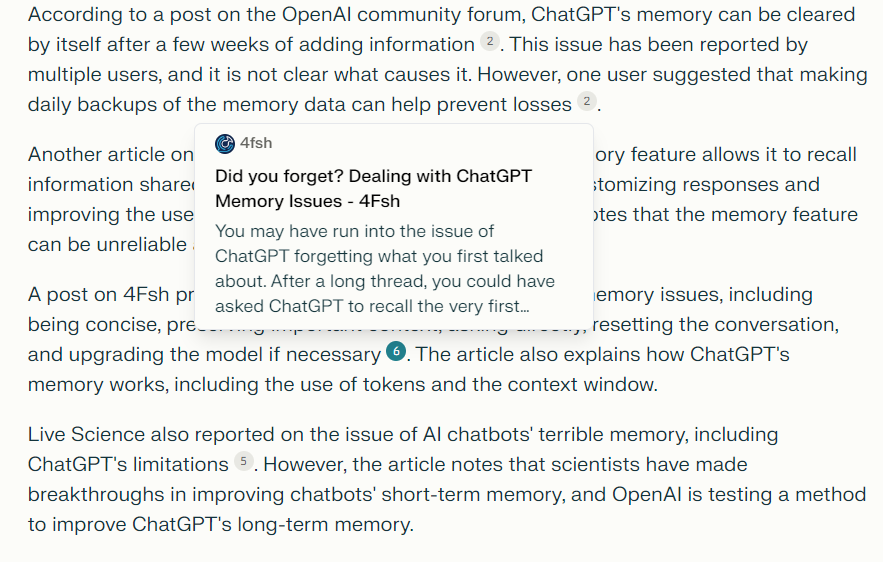6 Generative Engine Optimization Strategies for Marketers in 2024
Learn 6 Essential Generative Engine Optimization strategies to boost you & your Client's content's in AI search results as a Marketer


Last year I wrote an article about how Generative Engine Optimization is Coming and why marketers should care. 10 months later, we have learned more about the field of Generative Engine Optimization (GEO) at 4Fsh, and have had success placing our blog in different AI tools like Perplexity and ChatGPT as a reputable source. Insert Homer Simpson Meme of entering the bushes and coming out a GEO Expert

As a marketer myself, staying ahead of the AI curve is important. Whether it’s to gain a competitive edge or to avoid being replaced by AI technologies, these are 11 strategies that you can benefit from in order to step into GEO Marketing.
What is Generative Engine Optimization (GEO)?
Generative Engine Optimization is the optimization of content for better visibility and performance in relation to AI technologies. In essence it involves optimizing your content so that it appears authoritative, trustworthy, and capable of answering queries conversationally.
GEO is different from SEO for obvious reasons, though they share similarities. SEO, or Search Engine Optimization, focuses on optimizing websites to rank higher in traditional search engine results pages (SERPs). GEO is designed for AI-driven search engines, for example Perplexity, ChatGPT, Gemini, or other online access AI tools.
Why should you care?
What if I tell you that you can see a potential increase by 42.6% in click-through-rates, 31.4% increase in conversion rates, and a 25.6% increase in average position for your website? Or if you optimize, you can see a 40% increased visibility in AI search results? According to a study by Aggarwal et al (2023), that is what they found.
Smaller websites, in particular, can work with GEO Marketers to compete with larger companies by focusing on niche topics and long-form keywords that AI models favor. In fact, small websites see on average a 115.1% increase in visibility with GEO practices.
Given the fact that there isn’t any “sponsored content” as you can see in Google search results, you can think of it as if all the companies are on the same starting line. It comes down to who is the better marketer.
What are the 6 strategies for GEO?
Given how fresh this type of marketing is, there aren't a lot of articles and research papers out there. But for the ones that do exist, we've aggregated the concepts, tested them out, and came up with 6 main strategies that led to our success. Our sources can be found in the references section.
1. Prioritize Content Quality and Relevance
Prioritizing high-quality, relevant content is the most important aspect of GEO. Think about the SEO questions you want to address. For instance, “How can job seekers optimize resumes for ATS?” was the SEO question we focused on answering in “8 Strategies to Outsmart AI Applicant Tracking Systems”. High-quality content not only engages your readers, but also aligns with AI-driven algorithms.
Another example is if your target audience consists of small business owners, making sure your content includes practical advice and solutions tailored to specific challenges. Including metrics like industry statistics and case studies would help with the perceived authority of your content.
That is why relevance is very important for GEO. AI search results prioritize content that is contextually relevant to what the user is asking. So in our case, if someone is asking about ways to outsmart an AI ATS, we would pop up.
Just like in normal SEO, use tools like Answer The Public to figure out what questions your audience is likely to ask. If you find the trending question you want, make sure to create relevant content as naturally as you can.
2. SEO is still Alive and Kicking. Use it
Despite GEO gaining traction, traditional SEO techniques and metrics are still just as important and can be transplanted into the new field. For instance, Google’s Experience, Expertise, Authoritativeness, and Trustworthiness (E-E-A-T) plays an important role in how AI-driven search engines find your content. Other metrics, like impressions and engagement analytics serve a role with GEO as this is how AI measures how popular and trustworthy your content is.
Make your content display expertise. Expertise can come across as if you were writing an essay in college, with citations of studies or industry reports to enhance credibility for your statements. We will talk more about this in the next few sections.
Measure said traffic based on engagement metrics such as clicks, likes, and shares. These metrics show how users interact with your content and what drives the most engagement. Designing with these in mind will make sure your content looks visible, relevant, and valuable to your audience, as far as the AI search is concerned.
3. Keep in Mind Your Authority
When optimizing for GEO, you need to establish authority within your specific domain. This involves using industry-specific terminology, previous techniques like E-E-A-T, and using the right long-form keywords. For example if you are trying to get Perplexity to rank your marketing content higher than Hubspot, you can include terminologies like what we list here. Remember to make it flow smoothly.
Domain-specific optimization tailors your GEO strategies to better target audience interests and search behaviors, enhancing visibility and relevance. In the above example, high-quality relevant content is foundational for long-form keyword searches. Domain-specific optimization builds on this by addressing the unique needs of different fields, ensuring your content resonates with both AI-driven search engines and human readers.
If you are writing about tech advancements for example, including comprehensive reviews of new technologies, expert opinions, and relevant statistics can add significant weight to your content. AI algorithms prioritize content that is well-researched and authoritative, making it essential to incorporate credible sources and evidence.
By consistently producing high-quality, expert content, you can establish your website as a reliable source within your domain, thereby improving your rankings and visibility in AI-driven search results.
And there’s a right way and a wrong way to do citations. We’ll go into that next.
4. Include Citations, Quotations, and Statistics
Incorporating citations, quotations, and statistics can significantly boost your content's visibility and credibility. Well-researched content that references authoritative sources aligns with the principles of E-E-A-T, enhancing trustworthiness and informativity for both SEO and GEO.
Citations:
You can do this with APA (American Psychological Association), MLA (Modern Language Association), or through in-line linking or others. Just cite your work.
- APA is great for academic and professional writing, which is in the format of the author’s last name, the year of publication, and a page number if applicable.
- MLA is pretty common for the humanities. Citation is with the author’s last name and page number in parentheses. For example: (Smith 23).
- In-Line Linking is great for digital content to enhance readability and user experience.
It all comes down to personal preference and your target audience. My personal preference is using APA, as it allows people more quickly view sources collectively at the bottom. We held a vote at 4Fsh on which one to use consistently.
Quotations:
Quotations are another powerful tool. Including quotes from recognized thought leaders in your field lends credibility and strengthens the trust in your content. As you can see in the chart, the average improvement with GEO rankings goes up by 30.3% with quotations. Remember how we mentioned authority and content quality? This ties back to that.
Statistics:
Similarly, statistics and metrics are great for increasing trust. Remember to make sure these sources are up to date though. A general rule of thumb: 3 years is usually the limit for sources with 5 years depending on the field.
A Source Cheat Sheet
If you’re using citations for a fast moving field, make sure to avoid sources older than 3 years. For slower fields like education and social sciences, 5 years would be the cut off point, but ideally the more recent the better. History and literature are slow-paced fields and don’t generally have a time limit.
For statistics, within 2 years is a good benchmark. Older can be used if it’s the latest available or if there is a historical comparison. Quotations remain valid if they offer timeless insights. That said for current debates, stick to 2 to 3 years for relevance. If you’re talking about current events, stick to the last year as much as possible. Evolving issues within 3 years can be seen as the limit.
You can read more about it here to cite better for AI.
5. Intent-Specific Optimization
AI searches approach queries differently than Search Engine Results Page (SERP) results. You google a question, and the search engine returns a page with various different options, with pay-per-click (PPC) ads and organic search results.
In contrast, AI searches will analyze multiple sources, synthesize it, and give you what it thinks is both the most authoritative and relevant response. Plus it often has sources too, which people can click to go directly to your site. This way you skip the PPC line of traditional SERP results to get your page in front of the client.
So how can you tailor your content for intent? We went through long-form keywords, making your high-quality content have domain authority, using quotes, statistics, and citations. Something we did not go through is navigational optimization.
Navigational optimization is designing your content with a clear hierarchical design for AI algorithms. By using H1 to H5 headings to organize your content, you are making it easy to navigate. Additionally, including clear sections and answers, toggles, FAQs, or step-by-step guides can raise the score for your content’s usability and relevance for intent optimization.
A wall of text though, wouldn’t do that. And that lines up with our last strategy for Generative Engine Optimization: Fluency.
6. Optimize for Fluency
Fluency optimization in this context is making your content easily readable, as in “I am fluent in English” or French, or Italian. What does that mean in the context of AI search engines?

Sign up for 4Fsh
Essential Articles to help you stay ahead of the AI Curve
No spam. Unsubscribe anytime.
It means that they can easily understand and get to the point of your content. For example, if you’re talking about an advanced topic, breaking it down into digestible chunks and subheadings to guide the reader is helpful. Even if that reader is AI.
This approach makes sure that AI can better parse and comprehend your content, supporting its ability to deliver relevant results.
To optimize your content for fluency, it’s also important to make sure your text is free from grammatical errors and is well-structured. Running your text through a spell-checker and grammar tool can help with that. Since you will be posting online content, in general keeping paragraphs to up to 3 or 4 sentences is better for clarity and conciseness.
Using transitional phrases to connect ideas, bullet points to break up lists, visual charts to support text, and clearly expressing data points are all tools you have at your disposal.
And finally, explaining technical terms and concepts helps set your content as authoritative and ranks higher than your competitors, especially if you are showing domain expertise.
To Bring it all Together
If there's one thing to keep in mind when creating GEO content as a marketer, it is to focus on relevancy. Relevancy means that you are answering what people are searching for. And if they are searching, they want in-depth high quality knowledge. It also means showing your domain expertise. It means doing research for your writing, as well as having the right sources to make your content believable. And it also means you will be able to get your or your client's content in front of AI-driven search results without needing to pay for PPC ads.
What a time to be alive.
References
Aggarwal et al. (2023). GEO: Generative Engine Optimization. arXiv. Retrieved from https://arxiv.org/pdf/2311.09735.pdf
Princeton University. (2022). Generative Engine Optimization. Retrieved from http://arks.princeton.edu/ark:/88435/dsp011z40kx12c
Single Grain. (2024, March 26). Generative Engine Optimization (GEO): The Future of SEO. Retrieved from https://www.singlegrain.com/blog/ms/generative-engine-optimization/
Rich Sanger. (2023, December 19). Generative Engine Optimization: Maximizing Visibility in AI. Retrieved from https://richsanger.com/generative-engine-optimization-maximizing-visibility-in-ai/
Search Engine Land. (2023, December 19). Generative Engine Optimization framework introduced in new research paper. https://searchengineland.com/generative-engine-optimization-framework-introduced-research-paper-435855
Foundation Inc. (2023). What's Generative Engine Optimization (GEO) & How To Do It. https://foundationinc.co/lab/generative-engine-optimization
Semrush. (2023, October 10). SEO Trends in 2023: The Ones You Need to Know About. https://www.semrush.com/blog/seo-trends/


.jpg)




















